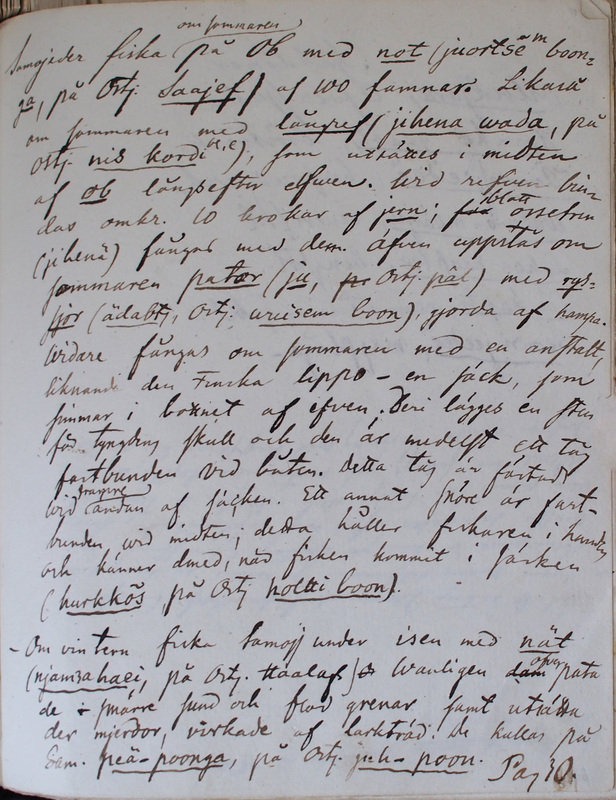Ethnographiska, historiska och statistiska anmärkningar. 248
Title
Ethnographiska, historiska och statistiska anmärkningar. 248
Description
| Samojeder fiska om sommaren på Ob med not
(juortse~m boonga,
på Ostj[akiska]. Saajef) af 100 famnar. LikasåTN ёрцьмʹ понгга ʻseine (net)’
om sommaren med långref (jihena wada,
påTN ехэнаʹ вадаʹ literally ʻsturgeon hooks’ denotes a longline (Chomič 1966: 78).
Ostj[akiska]. nis kordiы, e), som utsättes i midten af Ob långsefter elfwen. Wid refwen bin- das omkr[ing]. 10 krokar af jern; blott ossetren (jihenä) fångas med dem. Äfven uppstås om sommaren pator (ju
Ostj[akiska]. pâl) med rys-TN ю ʻfish weir’
sjor (ädabts, Ostj[akiska]. wuìsem boon), gjorda af hampa. |
In the summer the Samoyeds fish in the River Ob with nets (juortse ~ m boonga, in Ostyak Saajef) 100 fathoms wide and also in the summer with a long line (jihena wada, in Ostyak nis kordiы, e), which is exposed in the middle of the Ob across the stream. Around ten hooks made of iron are tied to the long line; only sturgeon (jihenä) are caught with them. Additionally, in the summer they set weirs (ju in Ostyak pâl) and fyke nets (ädabts, in Ostyak wuìsem boon), made of hemp. |
| Widare fångas om sommaren med en anstalt, liknande den Finska lippo - en säck, som simmar i bottnet af elfven. Deri lägges en sten för tyngdens skull och den är medelst ett tåg fastbunden vid båten. Detta tåg är fästadt wid framre andan af säcken. Ett annat snöre är fast bunden wid midten; detta håller fiskaren i handen och känner d[är]med, när fisken kommit i säcken (hurkkõs, på Ostj[akiska]. noltti boon). |
Additionally, they fish during the summer with a device similar to the Finnish lippo – a sack which swims in the bottom of the river. A stone is placed in it as a weight and it is tied to a boat with a rope. This rope is tied to the front of the sack. Another string is tied to the middle; the fisherman holds this in his hand and thus notices when a fish has come into the sack (hurkkõs, in Ostyak noltti boon). |
| Om vintern fiska Samojj.[Samojeder] under isen med nät (njamзahaei,
på Ostj[akiska]. Haalaf). Wanligen dam ofver pataTN нямзахэй ʻfyke net’
de i smärre sund och flod grenar samt utsätta der mjerdor, virkade af larkträd. De kallas på Sam[ojediska]. peä-poonga,
på Ostj[akiska]. juh-poon.TN пя понгга verbatim ʻwooden net’, a portable fish trap, typically woven from hemp (Chomič 1966: 79).
|
In winter, the Samoyeds fish under the ice with nets (njamзahaei, Ostyak Haalaf). They usually build weirs in smaller narrows and branches of rivers; they also set fish traps crocheted from larch. In Samoyed they are called peä-poonga, in Ostyak juh-poon. |
| Pag. 30 |
Page 30 |
[[the page is upside down]]

